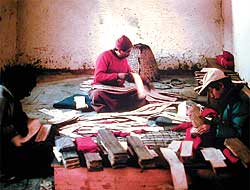 The Research Scheme Nepal Himalaya was born in 1959, exactly 100 years after the death of the brilliant German explorer, Alexander von Humboldt. Growing out of earlier German expeditions to the Himalayan region, the scheme proposed to undertake a comprehensive scientific study of all aspects of Nepal. It was funded by ministries in Bonn with the privately-managed Fritz Thyssen Stiftung.
The Research Scheme Nepal Himalaya was born in 1959, exactly 100 years after the death of the brilliant German explorer, Alexander von Humboldt. Growing out of earlier German expeditions to the Himalayan region, the scheme proposed to undertake a comprehensive scientific study of all aspects of Nepal. It was funded by ministries in Bonn with the privately-managed Fritz Thyssen Stiftung. After a series of highly successful scientific expeditions, the Research Scheme ended in 1965 and was reincarnated as Thyssen House: a home for international scholars from all fields, disciplines and countries, united by an interest in Nepal. Two years later, in 1967, Thyssen House transformed itself into the Nepal Research Centre (NRC).
Today, the NRC offers assistance to visiting scholars from abroad who require institutional affiliation in Nepal. Language training, both in Nepali and in a range of local languages, are arranged. It also encourages visiting scholars to present or publish the results of their research findings while in Nepal. The centre has an active and high profile publishing series comprising of occasional monographs as well as the Journal of the Nepal Research Centre (JNRC), of which there have been twelve volumes to date.
 Finally, the centre assists scholars by providing them working facilities, including access to a well-stocked reference library, technical equipment, facilities for viewing microfilms, a working space as well as meals and accommodation. To foster lively academic exchange, the NRC also hosts an informal daily lunch to which both local and foreign scholars are invited and encouraged to share ideas over dal-bhat.
Finally, the centre assists scholars by providing them working facilities, including access to a well-stocked reference library, technical equipment, facilities for viewing microfilms, a working space as well as meals and accommodation. To foster lively academic exchange, the NRC also hosts an informal daily lunch to which both local and foreign scholars are invited and encouraged to share ideas over dal-bhat. Over the last 30 years, the NRC has been handling the Nepal-German Manuscript Preservation Project (NGMPP) that microfilms every important manuscript and historical document located in Nepal. The materials photographed include various branches of Hindu and Buddhist literature in languages such as Sanskrit, Tibetan, Nepali and Newari?texts which are of significance far beyond the boundaries of Nepal. Many of these manuscripts are the oldest or last remaining copies of important religious or historical works, and a significant number are so degraded that they are close to disintegration. Since 2002, the Nepal-German Manuscript Cataloguing Project (NGMCP) is setting up a detailed online catalogue of the manuscripts microfilmed by the earlier project.
Nepal Research Centre
(01) 4420 855
[email protected]
Mark Turin is a Visiting Scholar in Anthropology at Cornell University.
[email protected]


